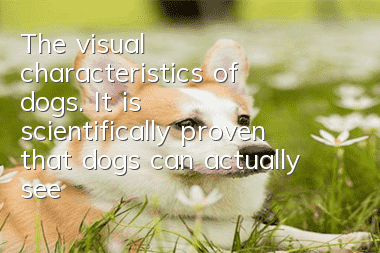The visual characteristics of dogs. It is scientifically proven that dogs can actually see colors.

The world in the eyes of dogs is not only black and white but also colorful
There are two kinds of color photoreceptors, or cone cells, on the dog’s retina, which can distinguish short wavelengths and medium and long wavelengths of light. They are the hues of blue (short wavelength) and red and yellow (long wavelength). Because dogs only have two types of cone cells, dogs can distinguish the same colors as humans who are red-green blind. But dogs do see certain colors. Dogs can distinguish different shades of blue, indigo and violet, but they have no special sensitivity to high-chroma colors such as red and green in the spectrum. One method is to shine a colored light source into a puppy's eyes and analyze the spectrum, or pattern, of the reflected light, and then compare the results with the analysis of the same light source into a human's eyes.
Red looks dark to dogs, and green looks white to dogs, so a green lawn looks like white grass to a dog.
The dog’s field of vision is very large but its adjustment ability is poor
The dog’s field of vision is very wide, and the left and right field of view of a single eye is 100-125 degrees. The upper field of view is 50-70 degrees. The lower field of view is 30-60 degrees. It can see the objects in front of it most clearly. At the same time, it is color blind. Dogs have a strong ability to distinguish shades of gray. Relying on this ability, dogs can distinguish changes in light and shade on objects and produce three-dimensional visual images. Dogs have poor vision. The lenses in their eyes are twice as thick as humans, so dogs are myopic. The adjustment ability of its eyes is only 1/5-1/3 of that of humans. It can be seen clearly within 50 meters, but cannot be seen clearly beyond this distance. But the moving target can feel the distance of 825 meters.
The reason why dog eyes reflect green light when illuminated by light is due to the choroid
Canine Retina The light receptor in dog eyes - the retina - contains a large number of columnar cells, and the columnar cells have Helps with vision in dark places and detecting moving objects. Another type of cell in the omentum is the optic cone cells. The function of the cone cells is mainly to distinguish colors and distinguish subtle details. There is an extra choroidal layer on the dog's retina, which is highly reflective and can also increase the dog's night vision. Because light entering the eye will hit the light receptor on the retina, it may also miss and penetrate the retina; but for dogs, due to the choroid layer, even if the light misses and does not hit the light receptor, it will still Reflected back onto the retina, causing what is called second sight. The choroidal layer of dogs is also the reason why dog eyes appear yellow, green, red and other scary colors when exposed to strong light.Different types of dogs have different vision
The relationship between dog vision and breed. Short-nosed dog breeds (such as bulldogs) can see a longer depth of field, while long-nosed dog breeds (such as shepherd dogs) ) has a wider field of view. In addition, the shape of the dog’s skull and the length of its nose are alsowill affect their vision. It is generally believed that most dogs are slightly myopic. A few people have hyperopia; but the degree of myopia and hyperopia is extremely rare. Random articles
- Is it better for Dogo dogs to have their ears erect or cropped? A case of Dogo dog’s ear erection surgery will tell you
- What do dogs eat to protect their stomach? It is important to protect their stomach and treat gastrointestinal diseases in dogs.
- How to tell if your dog is fat? Is your dog overweight?
- How to train Tibetan Mastiff Four aspects teach you how to train Tibetan Mastiff
- Will your dog catch a cold if you blow the air conditioner? What should you do if your dog catches a cold if you blow the air conditioner?
- What should you pay attention to when your dog drinks water? Don’t be careless when it comes to your dog’s drinking water.
- The dog's mouth bites and shakes. Why does the dog's mouth occasionally shake and bite?
- How to cut a dog's hair? Do you know how to cut a dog's hair correctly?
- Can dogs eat raw eggs? Why can’t dogs eat egg whites?
- Common Dog Problems in Summer How to Deal with Different Dog Problems



